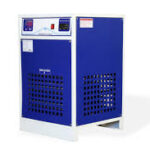Screw Chiller
Screw Chillers are a type of refrigeration system used for air conditioning or industrial cooling applications. They operate using screw compressors, which are efficient at handling large cooling loads. These chillers are known for their reliability and ability to maintain consistent cooling capacity over a wide range of operating conditions. They are commonly used in medium to large-scale commercial and industrial settings where high cooling capacity and efficiency are required.

Screw Chiller
Components of
- Screw Compressor: This is the heart of the screw chiller. It compresses the refrigerant gas, raising its pressure and temperature. Screw compressors are chosen for their efficiency and ability to handle large cooling capacities.
- Condenser: After compression, the high-pressure, high-temperature refrigerant gas flows into the condenser. Here, the gas releases heat and condenses into a liquid state through air or water cooling. The condenser is essential for transferring heat from the refrigerant to the external environment.
- Evaporator: Once the refrigerant liquid leaves the condenser, it enters the evaporator. In the evaporator, the refrigerant absorbs heat from the chilled water or the process fluid being cooled. This absorption causes the refrigerant to evaporate back into a gas state.
- Expansion Valve: This valve regulates the flow of refrigerant into the evaporator. It controls the pressure and temperature of the refrigerant entering the evaporator, ensuring efficient operation of the chiller system.
- Control Panel: The control panel houses the electrical and electronic components that monitor and regulate the operation of the chiller. It includes sensors, controllers, and sometimes a human-machine interface (HMI) for operators to monitor and adjust settings.
- Pumps: These are used to circulate the chilled water or process fluid through the evaporator and into the system that needs cooling. Pumps ensure proper flow rates and distribution of cooled fluid throughout the application.
- Heat Exchangers: Besides the condenser and evaporator, screw chillers may also include heat exchangers for transferring heat between different fluid streams within the chiller system. These can improve overall efficiency by recovering heat from various processes.
- Safety Devices: These include pressure relief valves, temperature sensors, and other devices designed to protect the chiller from overpressure, overheating, or other potentially damaging conditions.
Screw Chiller
Energy Efficiency on
- Ratio of Output to Input: Energy efficiency measures how much cooling a screw chiller produces compared to the energy it consumes.
- Coefficient of Performance (COP): Indicates efficiency by measuring cooling capacity per unit of electrical energy input.
- Technology Advancements: Modern screw chillers use advanced features like variable speed drives (VSDs) to optimize energy use based on demand.
- Component Efficiency: Efficient compressors and heat exchangers minimize energy losses and improve overall system performance.
- Operational Practices: Proper maintenance and operation ensure optimal performance and longevity, reducing energy waste.
- Environmental Benefits: Higher efficiency lowers operating costs and reduces greenhouse gas emissions from electricity consumption.
Screw Chiller
Characteristics of
- High Cooling Capacity: Screw chillers are capable of handling large cooling loads efficiently, making them ideal for medium to large-scale applications where significant cooling capacity is required.
- Energy Efficiency: They often feature high efficiency due to advanced compressor technology, such as twin-screw compressors and variable speed drives (VSDs), which optimize energy consumption based on demand.
- Quiet Operation: Compared to some other types of chillers, screw chillers tend to operate more quietly, which can be beneficial in noise-sensitive environments.
- Ease of Maintenance: They are designed for ease of maintenance, with accessible components and straightforward service procedures, minimizing downtime during maintenance activities.
- Long Lifespan: When properly maintained, screw chillers can have a long operational lifespan, providing reliable cooling over many years.
Other Chiller Products We Manufacture
Air Cooled Chiller
Air-cooled chillers are refrigeration systems that use air to dissipate heat from the coolant or refrigerant. Unlike water-cooled chiller, which rely on a water source and cooling towers
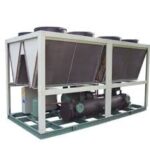
Water Cooled Chiller
Water Cooled Chillers are refrigeration systems that use water as a cooling medium to transfer heat away from the refrigerant. They are widely used in large-scale industrial

Variable Speed Chiller
Variable Speed Chillers are refrigeration systems equipped with compressors that have variable frequency drives (VFDs). These drives enable the compressor motor to adjust its speed according to the cooling load demand.
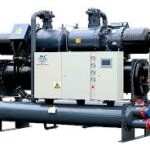
Oil Chiller
Oil Chiller are refrigeration systems designed to control and maintain the temperature of lubricating oil used in industrial machinery and processes. They ensure that the oil remains within a specified temperature range
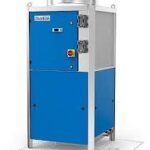
Hydraulic Oil Chiller
Hydraulic Oil Chillers are specialized refrigeration systems designed to cool and maintain the temperature of hydraulic oil used in hydraulic systems. They ensure that the oil remains within a specified temperature range
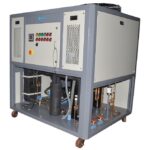
Online Chiller
Online Chiller is a refrigeration system designed to provide continuous cooling for industrial or commercial applications. It is equipped with capabilities for remote monitoring and control through internet connectivity
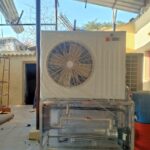
Glycol Chiller
Glycol Chiller is a type of cooling system that uses a glycol-water mixture as the coolant to remove heat from a process or equipment. Glycol chillers are commonly used
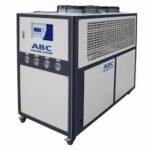
Spindle Chiller
Spindle Chiller are specialized cooling systems designed to manage the temperature of the spindle in machinery, such as CNC (Computer Numerical Control) machines.
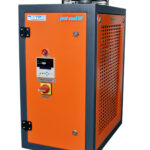
Refrigerated Air Dryer
Refrigerated Air Dryer is a type of device used in compressed air systems to reduce the moisture content of the air. It operates by cooling the compressed air to a temperature where water vapor condenses into liquid water.
